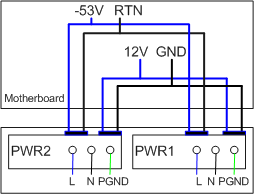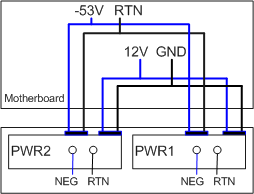S5730-68C-PWR-SI
Version Mapping
Table 1 lists the mapping between the S5730-68C-PWR-SI chassis and software versions.
Appearance and Structure
| 1 | Forty-eight PoE+ 10/100/1000BASE-T ports | 2 | Four 10GE SFP+ ports Applicable modules and cables:
|
| 3 | One ETH management port | 4 | One PNP button NOTICE:
Applicable in V200R012C00 and later versions: To restore the factory settings and reset the switch, hold down the button for at least 6 seconds. To reset the switch, press the button. Resetting the switch will cause service interruption. Exercise caution when you press the PNP button. |
| 5 | One console port NOTE:
It is used with a console cable. The console cable is not delivered with the switch and needs to be separately purchased if needed. |
6 | One USB port |
| 7 | Ground screw NOTE:
It is used with a ground cable. |
8 | ESN label NOTE:
You can draw it out to view the ESN and MAC address of the switch. |
| 9 | Rear card slot NOTE:
Card supported:
|
10 | Fan slot NOTE:
Applicable fan module: FAN-028A-B |
| 11 | Power module slot 2 NOTE:
Applicable power modules:
|
12 | Power module slot 1 NOTE:
Applicable power modules:
|
Interface Description
10/100/1000BASE-T port
USB flash drives from different vendors differ in model compatibility and drivers. If a USB flash drive cannot be used, try to replace it with another one from a mainstream vendor. Switches support a maximum of 128 GB USB flash drives.
Indicator Description
The S5730-68C-PWR-SI has the same types of indicators as the S5730-68C-PWR-SI-AC. For details, see Indicator Description.Power Supply Configuration
The S5730-68C-PWR-SI is a PoE switch. It has two power module slots, each of which can have a 500 W, 650 W, 1150 W, or 1000 W (applicable in V200R013C00 and later versions) power module installed. A 500 W AC power module and a 650 W DC power module can be used together in the switch. A 1150 W AC power module and a 1000 W AC power module can be used together in the switch. Table 6 lists its power supply configurations.
| Power Module 1 | Power Module 2 | Available PoE Power | Maximum Number of Ports (Fully Loaded) |
|---|---|---|---|
| 500 W or 650 W | – | 369.6 W |
|
| 500 W or 650 W | 500 W or 650 W | 739.2 W |
|
| 1150 W (220 V) | – | 785.4 W |
|
| 1150 W (220 V) | 1150 W (220 V) | 1440 W |
|
| 1150 W (110 V) | – | 446.6 W |
|
| 1150 W (110 V) | 1150 W (110 V) | 893.2 W |
|
| 1000 W (220 V) | - | 754.6 W |
|
| 1000 W (220 V) | 1000 W (220 V) | 1440 W |
|
| 1000 W (110 V) | - | 754.6 W |
|
| 1000 W (110 V) | 1000 W (110 V) | 1440 W |
|
| 1000 W (220 V) | 1150 W (220 V) | 1440 W |
|
| 1150 W (220 V) | 1000 W (220 V) | 1440 W |
|
| 1000 W (110 V) | 1150 W (110 V) | 893.2 W |
|
| 1150 W (110 V) | 1000 W (110 V) | 893.2 W |
|

When a switch has two power modules installed, the two power modules work in redundancy mode to provide power for the chassis and in load balancing mode to provide power for PDs.
Heat Dissipation
The S5730-68C-PWR-SI uses pluggable fan modules for forced air cooling. Air flows in from the left and right sides, and exhausts from the rear panel.


Technical Specifications
Table 7 lists technical specifications of the S5730-68C-PWR-SI.
Item |
Description |
|---|---|
Memory (RAM) |
1 GB |
Flash |
512 MB in total. To view the available flash memory size, run the display version command. |
Mean time between failures (MTBF) |
43.28 years |
| Mean time to repair (MTTR) | 2 hours |
Availability |
> 0.99999 |
Service port surge protection |
Common mode: ±7 kV |
Power supply surge protection |
|
Dimensions (H x W x D) |
44.4 mm x 442.0 mm x 420.0 mm (1.75 in. x 17.4 in. x 16.5 in.) When 1150 W power modules are installed, they stretch out from the chassis. Therefore, the total depth of the switch changes to 507.3 mm (19.97 in.). |
Weight (with packaging) |
8 kg (17.64 lb) |
Stack ports |
Any 10GE SFP+ or 40GE QSFP+ ports Ports on the 2-port QSFP+ rear stack card |
RTC |
Supported |
RPS |
Not supported |
PoE |
Supported |
Rated voltage range |
100 V AC to 240 V AC, 50/60 Hz -48 V DC to -60 V DC |
Maximum voltage range |
90 V AC to 264 V AC, 47 Hz to 63 Hz -38.4 V DC to -72 V DC |
Maximum power consumption (100% throughput, full speed of fans) |
|
Typical power consumption (30% of traffic load)
|
50.1 W (without card) |
Operating temperature |
0°C to 45°C (32°F to 113°F) at an altitude of 0-1800 m (0-5906 ft.) NOTE:
When the altitude is 1800-5000 m (5906-16404 ft.), the highest operating temperature reduces by 1°C (1.8°F) every time the altitude increases by 220 m (722 ft.). The operating temperature of the switch is 0°C to 40°C (32°F to 104°F) when it uses QSFP+ optical modules with 10 km or longer transmission distances. |
Short-term operating temperature |
-5°C to +50°C (23°F to 122°F) at an altitude of 0-1800 m (0-5906 ft.) NOTE:
When the altitude is 1800-5000 m (5906-16404 ft.), the highest operating temperature reduces by 1°C (1.8°F) every time the altitude increases by 220 m (722 ft.). The equipment can operate beyond the normal operating
temperature range for a short-term period, but the following conditions
must be met:
The equipment cannot start when the temperature is lower than 0°C (32°F). The maximum distance of optical modules used in these conditions cannot exceed 10 km. |
Storage temperature |
-40°C to +70°C (-40°F to +158°F) |
Noise under normal temperature (27°C, sound power) |
< 64.3 dB(A) |
Relative humidity |
5% to 95%, noncondensing |
Operating altitude |
0-5000 m (0-16404 ft.) |
Certification |
|
| Part number | 98010779 |


